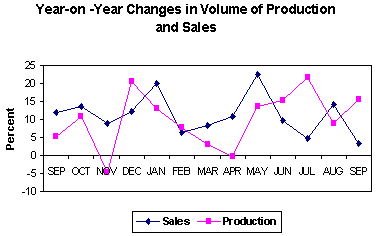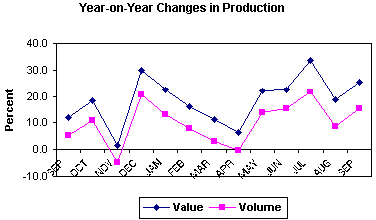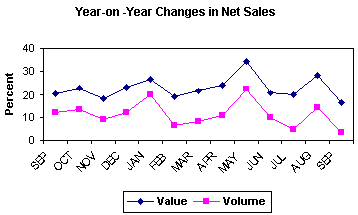Manufacturing Output Still Upward
Production output of the manufacturing industry climbed by 25.4 percent and 15.5 percent in terms of value and volume, respectively in September 2000 according to the preliminary results of the Monthly Integrated Survey of Selected Industries (MISSI).
Electrical machinery, wearing apparel, paper & paper products, and petroleum sectors contributed significantly to the overall performance of the manufacturing industry. The increases in the production of these sectors were due to the growing demand of both domestic and export market. Paper & paper products reported that in addition to the strong demand in the market, the expansion of manpower and improvement in the performance of their machinery contributed to their positive performance.
- Net Sales Move Up But Slower
Net sales volume in September 2000 grew by 3.4 percent but slower compared to the growths posted in August 2000 (14.3%) and September 1999 (11.9%). Value of net sales increased by 16.2 percent.

Manufacturers appear to have built up inventories in expectation of the holiday sales as the increase in the volume of production surpassed the growth of the volume of net sales.
Paper & paper products was the top gainer in terms of value and volume of net sales escalating by 75.9 percent and 77.3 percent, respectively from a year ago. On the other hand, the largest declines in value and volume of net sales were in basic metals.
- Producer Prices Still Up But Slower
Producer price index (PPI) rose by 8.6 percent to 152.7 in September 2000 from 140.6 in September 1999. The year-on-year increase in September 2000 PPI was slower compared to the 9.3 percent posted in August 2000 but higher than the 6.3 percent increment in September 1999.
Petroleum products had the highest year-on-year increase in producer price, moving up by 43.3 percent in September 2000. Other sectors which exhibited double digit increases in their producer price index were textile (24.2%), cement (21.2%), printing and publishing (16.8%), and electrical machinery (14.2%).
Increases in the producer prices could be attributed to higher cost of production inputs particularly of oil and other imported inputs aggravated by the weakening of peso.
- Average Capacity Utilization at 82.2%
Average capacity utilization rate for September 2000 for manufacturing was estimated at 82.2 percent which is the same rate posted in August 2000. However, this rate marked a 1.5- percentage point improvement over the 80.7 percent recorded in September 1999. Eleven out 16 sectors improved in terms of capacity utilization rate as compared to the same month last year. Electrical machinery had the highest capacity utilization rate of 91.5 percent while beverage posted the lowest capacity utilization rate of 63.7 percent.
- Value of Production
In September 2000, the value of production index (VaPI) of 684.8 increased by 25.4 percent from 545.9 in September 1999. Year-on year increases were observed in 11 out of 16 major sectors led by petroleum refineries, which increased by 52.5 percent (See Annex 1-A). Other sectors contributing double-digit growths to the value of production were the following: wearing apparel (49.7%), electrical machinery (47.51%), furniture & fixtures (38.7%), paper& paper products (36.3%), other manufacturing (19.8%), non-metallic minerals (17.4%) and rubber products (15.5%).
On the other hand, losers in terms of value of production were basic metals (-28.3%), wood & wood products (-24.9%), textile (-11.6%), food manufacturing (-8.9%), and tobacco (-1.3%).

- Volume of Production
The volume of production index (VoPI) for total manufacturing increased by 15.5 percent to 174.6 percent from 151.2 of the same month last year. Ten out of 16 sectors posted year-on-year increases led by wearing apparel with 42.2 percent increment. (See Annex 1-B). Other sectors which exhibited double-digit growths over their year-ago performance were furniture & fixtures (38.7%), paper & paper products (37.4%), electrical machinery (29.1%), other manufactures (28.0%) and rubber products (15.9%). The increases in the production output of these sectors can be attributed to the growing demand for the products in both domestic and export markets. Paper and paper products and electrical machinery also reported increases in labor inputs, and improvement in machine performance.
Losers in terms of volume of production were textile (-28.8%), basic metals (-25.9%), wood & wood products (-24.9%), food manufacturing (-9.7%) and beverage (-4.2%). The decline in the production in these sectors can be attributed either to lack of raw materials, temporary or partial shutdowns in the operation of some establishments due to strikes caused by some labor disputes and machinery breakdowns, or decrease in the demand for these products.
- Value of Net Sales
The value of net sales for September 2000 moved up by 16.2 percent compared to the same month last year. Eleven out of 16 major sectors showed improvements in their value of net sales. The leading sector was paper & paper products which edged up by 75.9 percent over the same month last year (See Annex 2-A). Other sectors that exhibited double-digit year-on-year growths in their value of net sales were petroleum products (49.2%), electrical machinery (36.9%), chemicals (13.3%), non-metallic minerals (15.2%), furniture & fixtures (48.4%) and miscellaneous manufactures (26.8%).

On the other hand, sectors with lower values of net sales as compared to the same month last year were basic metals (-31.6%), wood & wood products (-30.2), wearing apparel (-3.7%), textile (-2.9%) and tobacco (-2.4%).
- Volume of Net Sales
The volume of net sales for September 2000 increased by 3.4 percent over the same month last year. Increases were observed in 10 out of 16 sectors led by paper & paper products which expanded by 77.3 percent (See Annex 2-B). Other sectors that exhibited double-digit growths were electrical machinery (19.9%), chemicals (10.1%), non-metallic minerals (17.0%), furniture & fixtures (48.4%), and miscellaneous manufactures (35.5%).
On the other hand, decreases were observed in the following sectors: wood & wood products (-30.2%), textile (-21.8%), basic metals (-30.3%), wearing apparel (-8.6%), tobacco (-1.5%) and transport equipment (-0.9%).
- Capacity Utilization
The proportion of responding establishments that operated at full capacity (90%-100%) in September 2000 was 28.2 percent, higher by 14.2 percentage points from 14.0 percent in September 1999 (See Annex 3-A). About 35.2 percent operated below the 70 percent capacity utilization. This was lower by 12.8 percentage points from 48.0 percent in September 1999.
The September 2000 average capacity utilization rate for manufacturing was estimated at 82.2 percent, the same rate posted last year (See Annex 3B). Of the 16 sectors, eleven sectors posted higher capacity utilization rates as compared to a year ago. Leading sector was electrical machinery, which recorded an average capacity utilization rate of 91.5 percent. Other sectors which registered more than 80 percent capacity utilization rates were miscellaneous manufactures (90.2%), furniture & fixtures (90.8%), paper & paper products (87.7%), petroleum products (85.3%), wearing apparel (83.8%), chemicals (82.8%), tobacco (81.9%), food manufacturing (81.5%), rubber products (80.7%) and non-metallic minerals (80.6%).
- Response Rate
These results were based on the response of 371 sample establishments, which comprised 71.3 percent of the total number of establishments covered by the survey.










ANNEX 4

Source: National Statistics Office
Manila, Philippines
